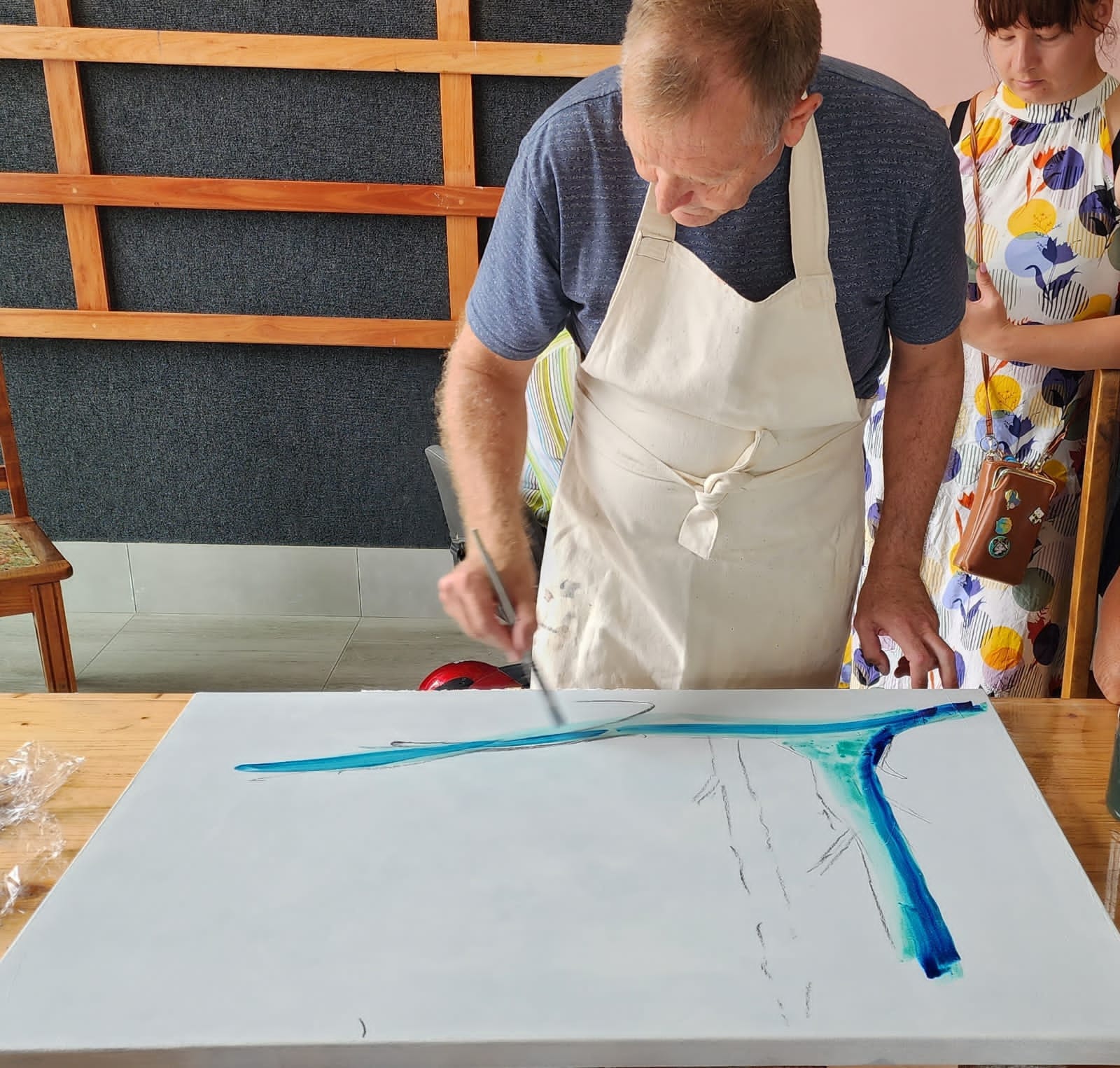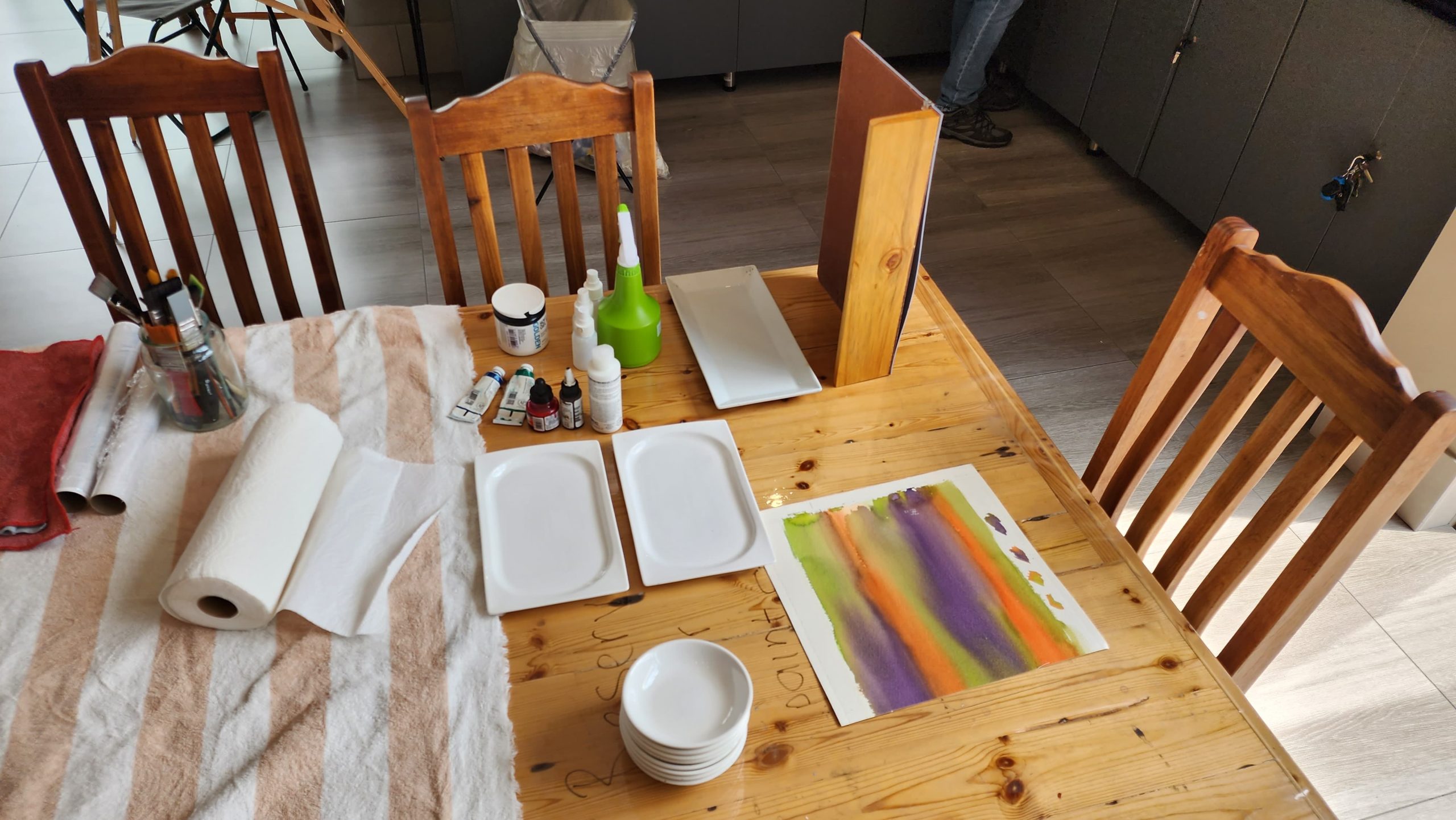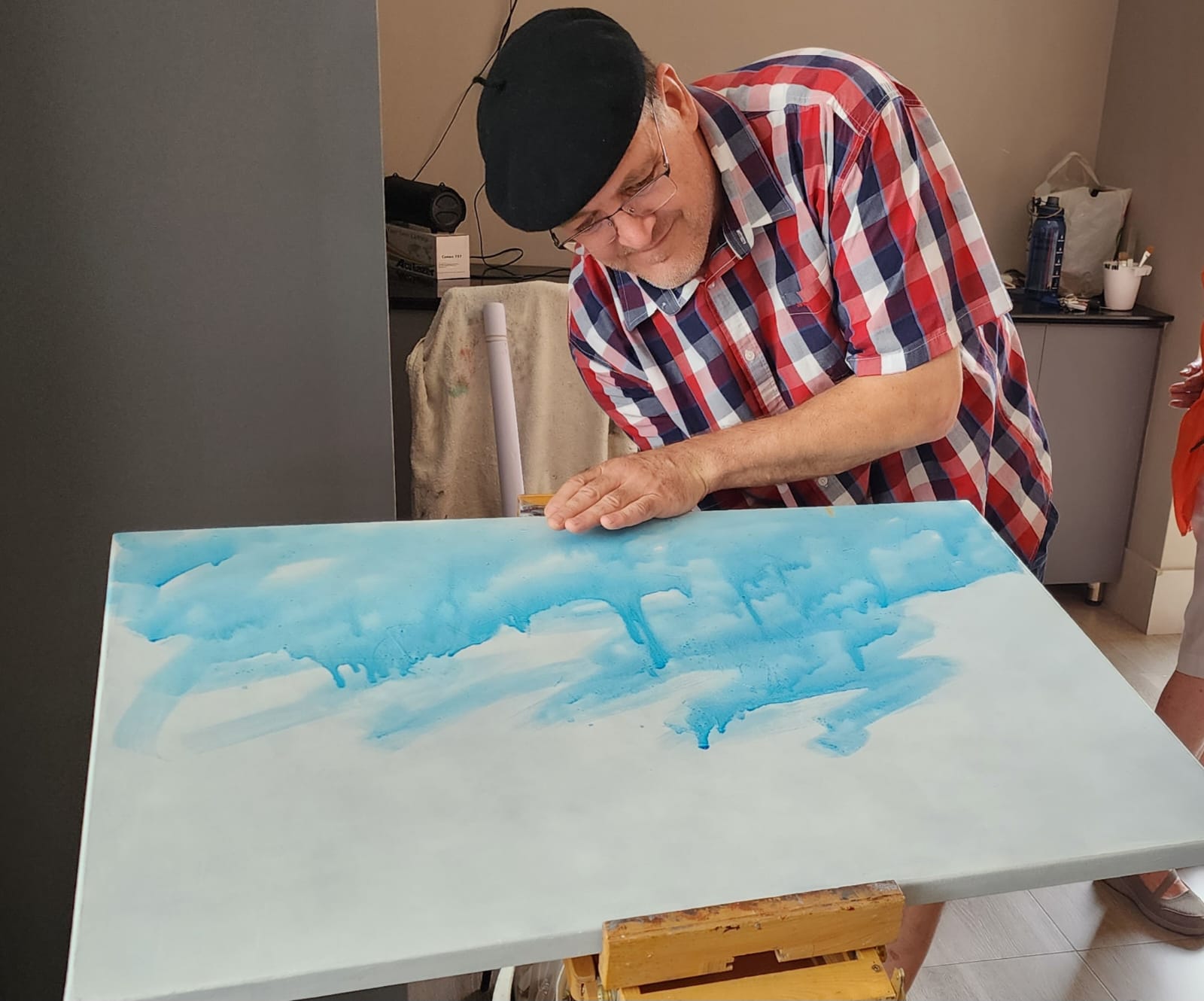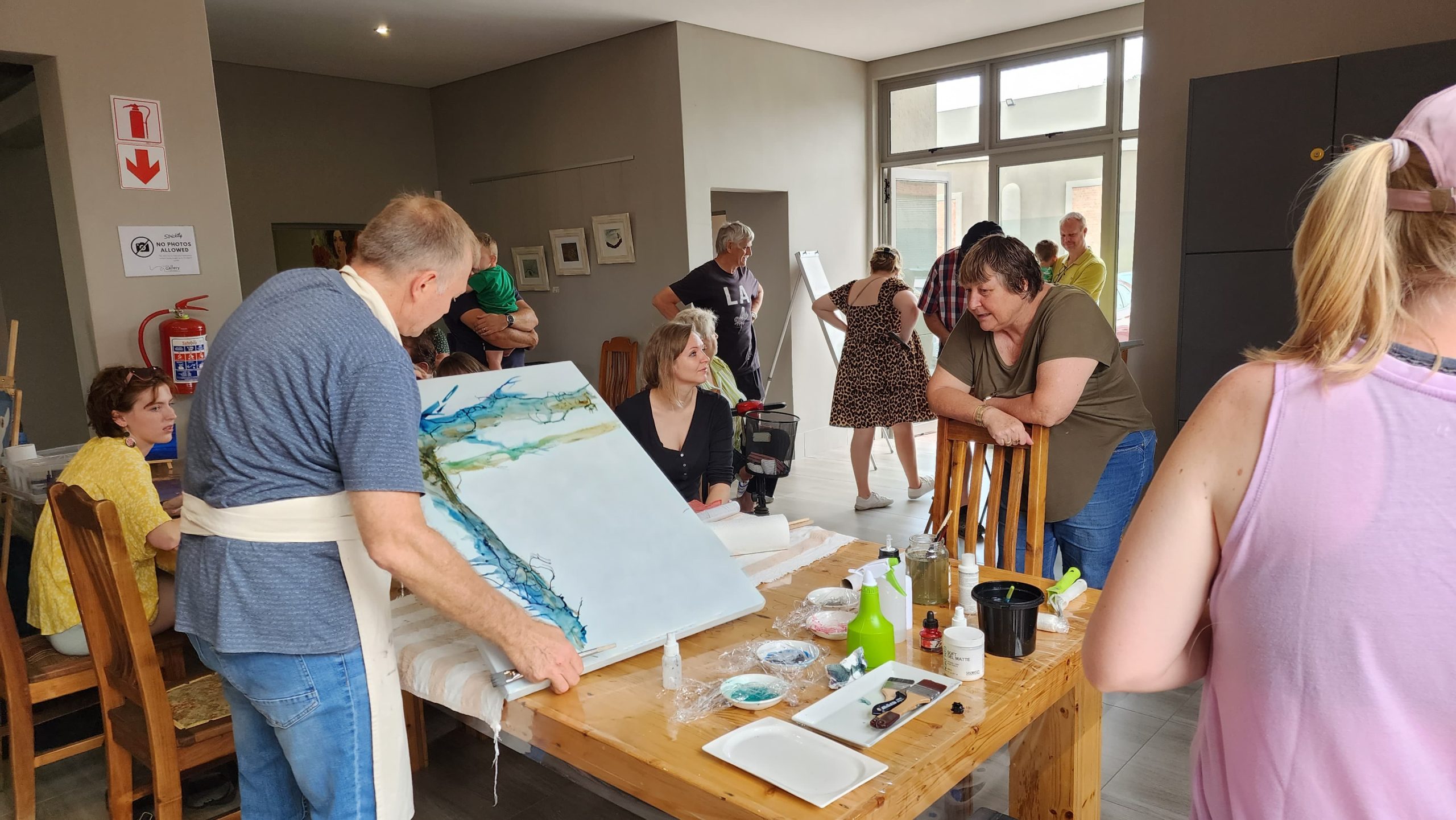Paint Off – Francois vs. Louis
By Chrizelda Garnett-Bennett
What a fantastic day. We learned a lot and played plenty. When seeing someone so proficient in their craft at work, one can’t help but wonder what goes through their heads. In the case of Mr. Francois Erasmus (challenger) and Mr Louis Trichardt (challenged), we had the opportunity to ask questions to our hearts’ desire.
Let us start from the beginning. The artist, Francois came up with the concept to start a “Paint-Off” against other artists in the gallery. The ‘theme’ consists of the challenger bringing art supplies for both competing artists, to see what they make of the medium. At the end of the given time frame, both paintings/works of art go out as prizes of a lucky draw. The challenged artist gets to pick someone else to compete with for the next round at a different time, thus creating a train of artists creating work and including us in their thought process.
Starting the day with a nice recycled black-to-white canvas, we see a nice shade of bluish-green peeking through to see a transformation commence. Landscapes seem to be the plan of action, and with a few watercolor tubes on the table, our medium is established as watercolor on canvas.

With the wine bottles open, the playful environment entices the rest of us to join in the creation process. Seeing the face of an oil painter staring at the provided water paint supplies comically gives me the courage to try new things. “Kokkerot” is the name being shouted to the Prussian blue on the table, a very strong pigmented colour that can easily infect and abolish the surrounding colours.
Red acrylic ink, Golden Fluid Acrylics, and Soft Gel also glisten on the table of supplies. Watercolour ground was used on the canvas as a base for the paint to stick, finished off with said Soft Gel, so our artists can start with colour almost immediately.
Louis starts by testing out the supplies on a practice piece of paper before starting on the canvas. A good practice to follow when working with new supplies. Like chickens the spectators cluck around the artist, not knowing or understanding what he’s busy with. Luckily this session is for the public to learn, to pick up new tricks, and to get a peek into the artists’ brains.
Francois tells us that the Viridian and Crimson ought to make a nice grey tone, which would be great for his concept. He starts by spraying the back of the canvas with water. Prepping the canvas is an integral part of preservation. The front of the canvas is also sprayed to start working, and charcoal is used to draw construction lines. Francois explains that on the wet canvas, the charcoal is absorbed and thus won’t mix within the actual colours of the paint.
90 minutes for the challenge, and both artists are prepping feverishly. Even within a competition setting, the prepping and planning are still essential.
Francois preps his bowls with glad wrap, covering the water colour paint along with a spritz of water. “The colours dry out quickly” is our answer when the chickens start clucking. Prussian Blue is Louis’ arch enemy, and that is apparently why our challenger chose this colour instead of his preferred Ultramarine Blue.

No bell or gunshot needed, as soon as Louis wets his brush, and Francois puts on his apron, the challenge starts. With both artists in full focus mode, we finally see what their process is. All the paint mixing happens on the canvas, so the paint on the pallets stays pure. The trademark of watercolour is the running colours, thus keeping the canvas on an angle lets the paint do its job. Seeing two experienced artists at work, really shows you that there’s no right or wrong way to be an artist.
After all the mixing, begins the wiping. Who needs a brush when you can control water? “You need to let go; you can’t control it” Francois says after controlling the water perfectly. Experience is what makes these movements seem effortless. Louis flipped his canvas to use the power of gravity to ‘grow his trees’ so to speak. Francois grabbed the hairdryer to speed up the process. “Only when you have 90 minutes, you’re allowed to use a hairdryer” he defends himself to the chickens with a smile. I experience watercolour as a very slow medium, especially when you use a lot of water to mix your colours and leave it to dry naturally.
Meanwhile, the chickens have left Louis to scavenge a few coffees at the Boere mall Market, leaving the artist some space to work with. Painting in front of people is a very different challenge compared to painting alone in a studio. Louis has made himself comfortable in a corner, as his setup has been perfected from his outdoor painting. Francois has taken over the main table and side table, tripling around like a fairy painting autumn leaves.

Layer upon layer, the messy colours turn into trees. Gravity and the wind of the hairdryer are tools both these artists use to their advantage. A symphony of hairdryers and a clucking crowd echo into the gallery, filling it with life and laughter. One never really thinks of a master artist as being anxious, but hearing them say “I’m really nervous” while seeing their beautiful trees grow, is both humbling and comforting.
Another tree is in the distance, and a third tree appears in Francois’ painting. “My canvas doesn’t even fit my easel” Louis exclaims with a big laugh. Even though this is a challenge, the challenger and challenged both exchange ideas and techniques to bring these trees to fruition. This is where we see the gift of community, learning from each other’s mistakes, and growing together into more experienced artists. A valid question from the crowd “Is the hairdryer warm or cold?” Since we don’t want to burn the paints and just dry them, sometimes moving around the droplets, it’s better to work in a cold setting.
Next, we have water speckles for texture vs. water drops for branches. The difference between using a water spray vs a clean alcohol spray, the water fades the paint whereas the alcohol clears the paint. Both create interesting patterns on the canvas, but different enough for two separate textures. Texture makes it look more realistic and pulls you into the painting.
While waiting for the watercolour to dry a bit, Francois explains to us that he plans to use the acrylic soft gel to cover some of the bright colours essentially sending his tree to the back of the painting. If he were to paint now, the colour would lift, and the tree would be stripped from the canvas. He used a roller to apply the sealant, leaving the tree visible and workable. The roller however does pick up and displace some of the kokkerot and tints the white background a shade of blue.
“Vaster, nie vas nie” the sealer is a semi-barrier to add more colour without removing too much. Louis is strategically removing his greens with a scrunched-up paper towel (another tool in the box) to create a grassy landscape. “80% of an artist’s work is watching paint dry,” Louis says as he’s waiting for his paint to dry.

“Now comes the risky part” Francois says as he prepares to cover his tree with diluted white paint. Long broad strokes of white paint and soft gel simplify the landscape. “Otherwise, the landscape is too busy or full”. The challenger usually works on steel plates and not on canvas, using watercolour as a base painting and finishing off with oil paints. “I usually add 7 or 8 more layers with a glazing technique, very thin, to finish up the painting” Francois tells us. Today is a challenge for him as well since the canvas gets wobbly with all the water. A special crowd member, Barbie, tells us an easy way to even out small dents on canvas is to pour boiled water inside when it’s still fresh and leave it out in the sun to dry.
Even with the same colours, medium, project, and canvas, you end up with vastly different images at the end of the day. Francois is the first to finish, “Sometimes you need to know when to stop.” A trap we often fall into is to continue tinkering on a piece that needs to be left alone. Once it’s done, it’s done. A lesson that the watercolour medium likes to teach us.
Quotes from our artists:
Francois – “90min is `n goeie underpainting, `n nice begin punt.”
Louis – “Lekker gewees, Nie geweet wat om te verwag nie, want nie geweet wat [Francois] sou bring nie”

